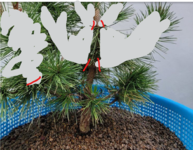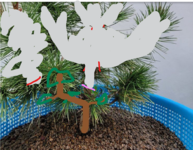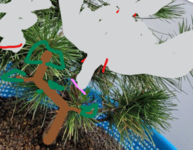The development of the JBP trunks in their natural state, as seen in mine, are seemingly straight up, with a couple bending to the side due to the heavy foliage on top. This is the thing that worries me as I will be hard pressed to develop most of the straight trunks in a literati style.
I mentioned earlier that we need to see not what is there now but what could be there in a few years.
Maybe this series of drawings will help understand how a straight trunk could become informal upright without bending the existing thick trunk.
This is one of your trees. Currently a straight trunk.

The main trunk is stripped of side branches for Teleperion style sacrifice trunk. Longer lower branches trimmed to keep them compact while sacrifice grows to thicken the lower trunk. Keep just 2 lower branches to minimize thickening at the node creating reverse taper.

After some years of growth the lower trunk is now thicker. The long sacrifice trunk is chopped off leaving just the few lower branches we have retained and pruned occasionally to keep them compact.
A branch on one side now becomes the main trunk. The other branch becomes a side branch. Further similar pruning along the longer branch (new trunk) will give further similar bends, branches and new leader each time - brown lines show new trunk line and main branches.

Tilt the tree to the right to bring the trunk more upright. Hoping you can trim some roots to allow for surface roots to show better nebari. Note that it may be better to tilt the tree much earlier to allow roots to grow at the new angle to form better nebari.

The tree is now a much thicker trunk with good bends using pruning and growing only. Some wiring may assist with branch placement an bends in thinner branches.




